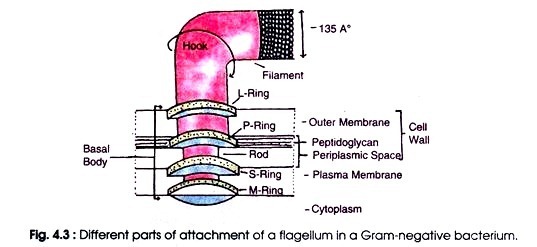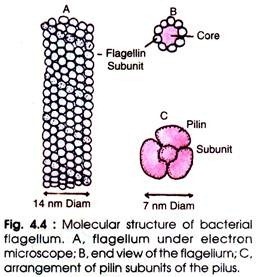The structure of bacterial flagella have been described by Simon (1978), Doestsch and Sjoblad (1980) and Ferris and Beveridge (1985). A flagellum consists of three basic parts, the basal body, hook and filament (Fig. 4.3).
(a) Basal body:
M. L. De Pamphilis and J. Alder (1971) isolated the basal body of a flagellum of E. coli and B. subtilis and studied its fine structure and arrangement of rings. The basal body attaches the flagellum to the cell wall and plasma membrane. It is composed of a small central rod inserted into a series of rings.
In Gram-negative bacteria two pairs of rings, the proximal ring and the distal ring, are connected by a central rod. There are two pairs of rings i.e. four rings are L-(lipopolysaccharide) ring P-(peptidoglycan) ring, S-(super membrane) ring, and M-(membrane) ring.
The outer pair of rings, L-ring and P-ring, are attached to respective polysaccharide and peptidoglycan layer of cell wall, and the inner pair of rings i.e. S-ring and M-ring are attached to cell membrane.
The outer rings form a bearing for the rod to pass through it. In Gram-positive bacteria only the distal (inner) pair of rings is present. The S-ring is attached to inside thick layer of peptidoglycan and M-ring is attached to cell membrane.
(b) Hook:
The hook is present outside the cell wall and connects filament to the basal body. It consists of different proteins. The hook in Gram-positive bacteria is slightly longer than the Gram-negative bacteria.
(c) Filament or shaft:
The outermost long region of the flagellum is called filament or shaft (Fig. 4.3). It has a constant diameter and is made up of globular proteins, the flagellin. the flagellins are arranged in several chains that intertwine and form a helix around a hollow core (Fig. 4.4). The proteins of flagella act to identify certain pathogenic bacteria unlike eukaryotes, the filaments are not covered by a membrane or sheath.


